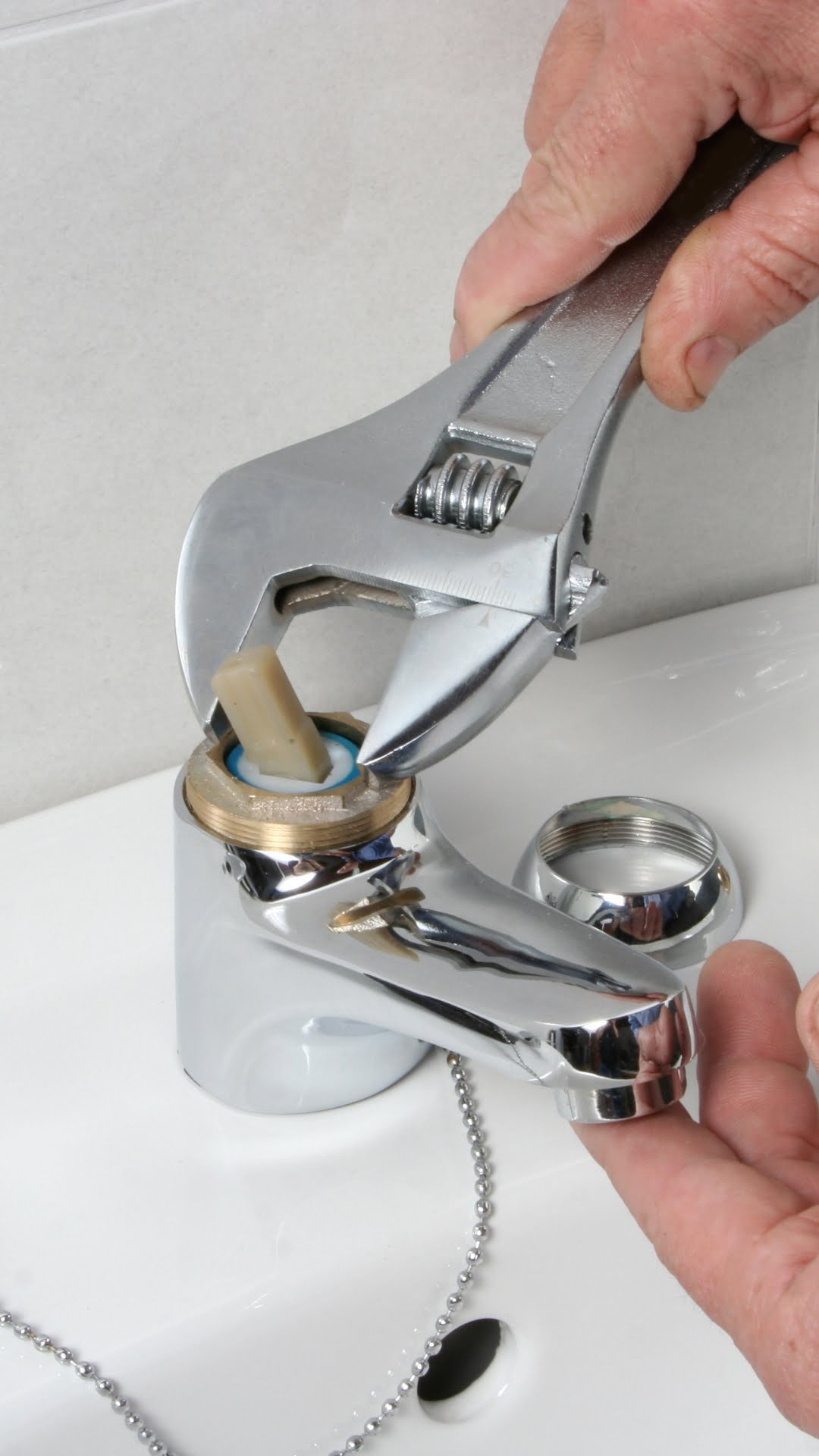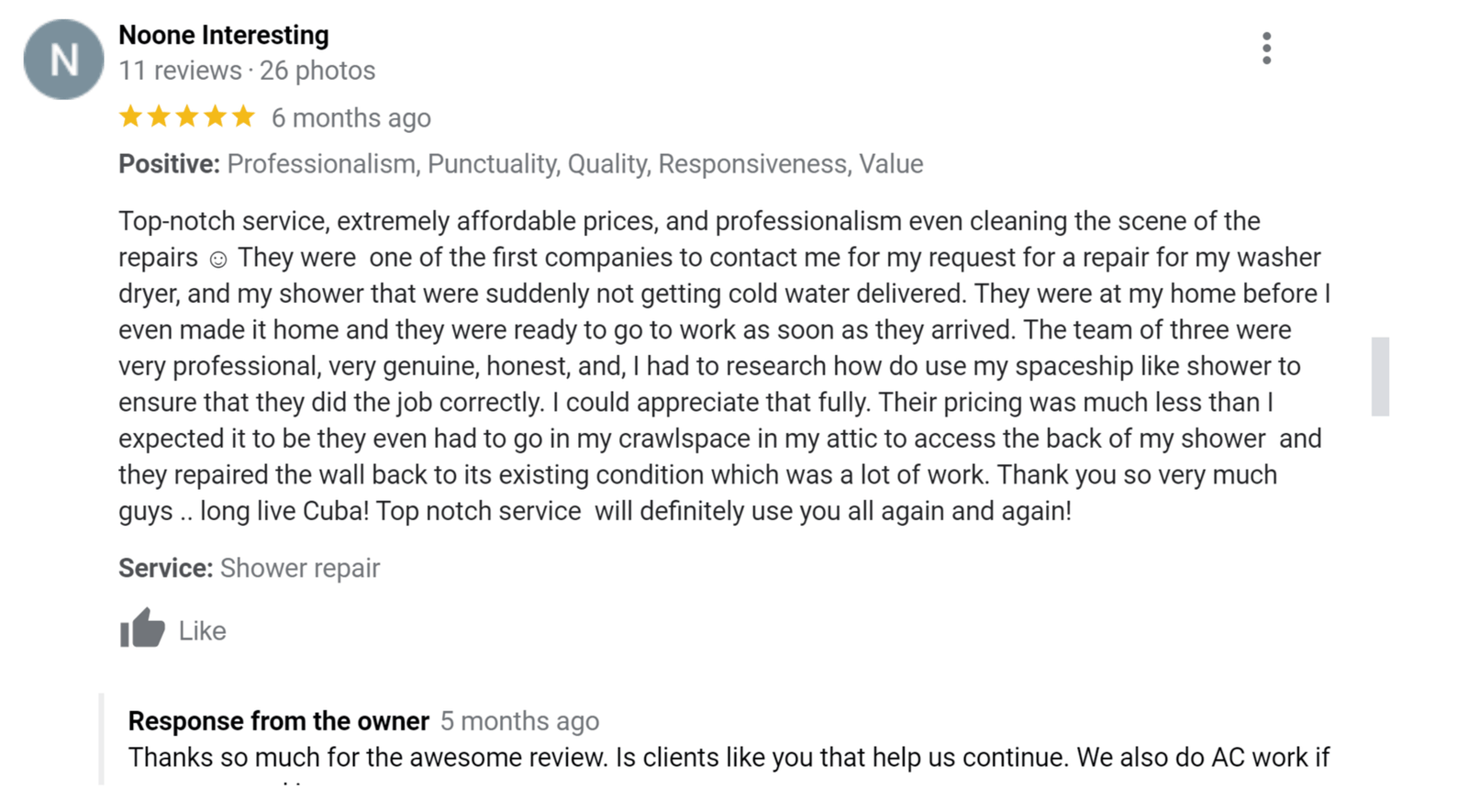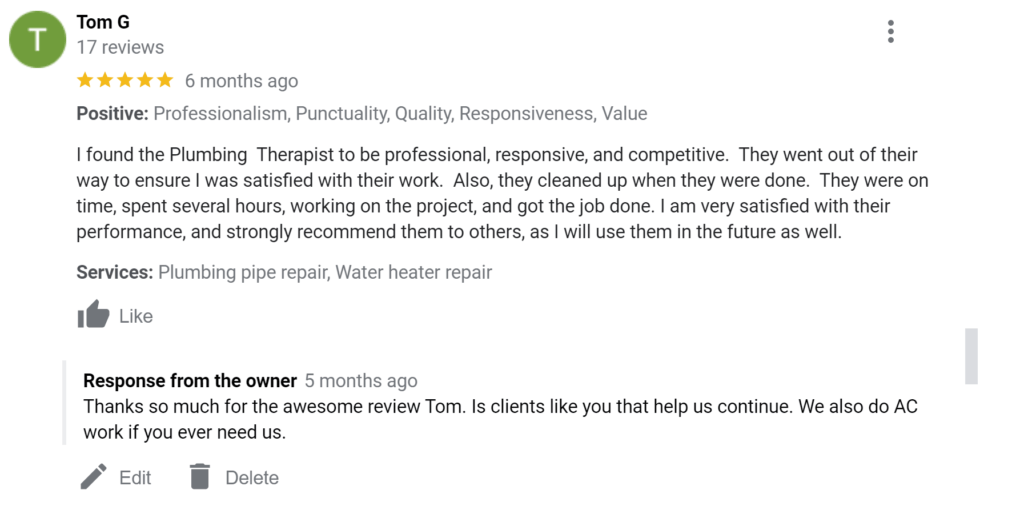Faucet Repair
Experience prompt and professional faucet repair services with Plumbing Therapist. From leaky taps to complete faucet overhauls, our skilled technicians ensure your fixtures function flawlessly, enhancing your home’s efficiency and preserving its charm. Trust us for top-notch solutions in Tampa Bay.
Do You Need Our Help ?
Feel free to contact us now
$99 Water Heater Flush + Free Plumbing System Inspection
Faucet Repair in Tampa Bay
Reliable & Effective Faucet Repair Services in Hillsborough County, Pinellas County, and Pasco County
Don’t Let Drips Drain Your Wallet – Call the Experts!
At Plumbing Therapist, we understand that a dripping faucet is more than a minor annoyance, it’s a cry for help from your plumbing system. That’s why we offer comprehensive faucet repair services throughout the Tampa Bay area, ensuring that your minor issues don’t turn into major headaches.
Why Choose Plumbing Therapist for Your Faucet Repairs?
Prompt Service: We pride ourselves on our quick response times. Our team is ready to tackle your plumbing problems promptly, ensuring minimal disruption to your daily routine.
Experienced Technicians: Our skilled plumbers are well-versed in repairing all types of faucets, from the traditional compression type to the more modern ceramic disk models.
Cost-Effective Solutions: We provide transparent pricing and efficient repair solutions designed to save you money in the long run by avoiding costly water waste.
Quality Parts and Tools: We use only the highest quality replacement parts and the latest tools to ensure that your faucet works smoothly after we’ve finished our repairs.
Guaranteed Satisfaction: Our job isn’t done until you’re completely satisfied with the results. We stand behind our work with a robust service guarantee.
Our Faucet Repair Services Include:
- Leak Diagnostics: Identifying the source of drips and leaks to provide targeted repairs.
- Washer and O-Ring Replacement: Common fixes that can address a leaking faucet.
- Aerator Cleaning and Replacement: Solving low water pressure issues and preventing splashing.
- Valve Seat Repair: Addressing the connections within your faucet to prevent leaks.
- Full Faucet Replacement: When repairs are not enough, we can install a new faucet that fits your style and needs.
Ready for a Repair?
Don’t let a leaky faucet disrupt your day or inflate your water bill. Contact Plumbing Therapist today at (813)-437-4477 or schedule your service online. Our friendly team is ready to bring the therapy your plumbing needs with expert faucet repair services that you can trust.

Why partner with Plumbing Therapist?
Quality, Affordability, and Expertise.

No Hidden or Unexpected Charges

Free Estimates & Online Booking Available

Professionally Trained Technicians

Honesty is Guaranteed

Quick Communication & Service Within 24 Hours

400+ 5 Star Reviews

Why do I need to repair your faucet?
Repairing a faucet is essential for several reasons:
Water Conservation: A dripping faucet can waste a significant amount of water over time, leading to higher utility bills and unnecessary water wastage, which is not environmentally friendly.
Cost Savings: By addressing a leaky faucet promptly, you can save money on your water bill. Even a small drip can add up to gallons of water wasted each day.
Prevent Damage: Water from leaks can cause damage to your sink area, countertops, and cabinets, leading to costly repairs or replacements if not addressed.
Maintain Water Pressure: A malfunctioning faucet can also affect water pressure. Repairing it can restore proper water flow and pressure.
Avoid Mold and Mildew: Continuous moisture from a leak can lead to the growth of mold and mildew, which can be harmful to your health and can cause unpleasant odors.
Aesthetic and Function: A well-functioning faucet maintains the aesthetic appeal and functionality of your kitchen or bathroom, ensuring a comfortable and efficient home environment.
Property Value: Keeping all plumbing in good repair is important for maintaining the value of your property.
Peace of Mind: Addressing faucet repairs promptly can give you peace of mind, knowing that you’ve averted potential further damage and costs.
Plumbing Therapist is here to help you with all your faucet repair needs, ensuring that your plumbing is in top condition and providing you with all the above benefits.
If you would like more information, feel free to give them a call at (813)-437-4477 or you can book online and get their latest discount!
Customer Testimonials: Real Experiences with Plumbing Therapist
We proudly share the experiences and stories of our valued clients. Their feedback provides a glimpse into the quality of service and commitment to excellence we uphold at Plumbing Therapist. You'll read firsthand how our plumbing solutions have improved comfort and efficiency in homes across Tampa Bay. These testimonials illustrate our dedication to customer satisfaction and the difference our expert services can make.




Your questions answered
Common Faucet Repair Questions:
Why is my faucet dripping even after I've turned it off tightly?
A faucet may continue to drip after being turned off tightly for several reasons:
Worn Out Washer: The washer inside the faucet can become worn out over time due to the friction that occurs when the faucet is used. This is one of the most common causes of a dripping faucet.
Damaged Valve Seat: The valve seat can become corroded or covered in mineral deposits, causing leakage around the spout.
Improper Washer Installation: If the washer is not the correct size or not installed properly, it can cause dripping.
Worn Out O-ring or Seals: In cartridge faucets, the O-rings or seals can wear out, leading to a leak near the handle.
Broken Parts: Other internal parts, such as a worn-out valve assembly or gaskets, can also cause dripping.
High Water Pressure: Sometimes, the water pressure can be too high, causing water to leak out of the faucet intermittently.
Corroded Pipes or Fittings: Corrosion in the water supply lines or fittings can also lead to leakage.
It’s important to address a dripping faucet promptly to prevent further damage and water waste. If you’re not comfortable with DIY repairs or if the problem persists, it might be time to call a professional from Plumbing Therapist to assess and fix the issue.
How do I know if my faucet needs repair or replacement?
Determining whether your faucet needs repair or replacement can depend on several factors:
Age of Faucet: If your faucet is very old, it might be more cost-effective to replace it rather than continue to repair it.
Frequency of Repairs: If you find yourself repairing the faucet often, it may be time to replace it to avoid the hassle and expense of frequent maintenance.
Extent of Damage: Minor issues like a worn washer or o-ring can usually be repaired. However, if there is significant corrosion or the damage requires replacing multiple parts, it might be more prudent to replace the entire faucet.
Cost Comparison: Sometimes the cost of repairing a faucet, especially if it requires special parts, can approach or exceed the cost of a new faucet. In such cases, replacement might be the better option.
Performance Issues: If the faucet has a consistent performance issue, such as low water pressure or poor water flow even after repairs, it might be time for a replacement.
Water Efficiency: Newer faucets are designed to be more water-efficient. If your current faucet is a water waster, upgrading to a new model could be beneficial for the environment and your wallet.
Aesthetics: If the faucet’s style is outdated or it no longer matches your renovated kitchen or bathroom, you might choose to replace it for aesthetic reasons.
Leaks: Persistent leaks despite multiple repairs are a sign that the faucet may need to be replaced.
If you’re unsure whether to repair or replace your faucet, consulting with a professional plumber can provide guidance. A plumber from Plumbing Therapist can assess the condition of your faucet and give you an expert recommendation based on its current state and the cost-effectiveness of repair versus replacement.
Can I repair a leaky faucet myself, or do I need to call a professional?
Many minor faucet repairs can be handled by a homeowner with some basic DIY skills and tools. Here’s how you can assess whether to tackle the repair yourself or call a professional like Plumbing Therapist:
DIY Repair:
When to consider DIY:
- The repair is straightforward, such as replacing a washer, O-ring, or aerator.
- You have the necessary tools (like a wrench, screwdriver, and replacement parts).
- You feel confident in your ability to follow step-by-step instructions.
- There are plenty of resources available, including tutorials and guides.
Steps for DIY:
- Identify the type of faucet you have (compression, ball, disc, or cartridge).
- Turn off the water supply to the faucet.
- Disassemble the faucet to locate the issue.
- Replace any worn or damaged parts such as washers, seals, or O-rings.
- Reassemble the faucet and turn the water back on to test for leaks.
Professional Repair:
When to call a professional:
- The problem persists after you’ve tried a basic repair.
- You’re unable to identify the source of the leak.
- The faucet requires special tools or parts that you don’t have.
- You’re not comfortable with the complexity of the task.
- The repair involves dealing with water pressure issues or changes to the plumbing system.
Benefits of professional repair:
- Expertise in handling a wide range of plumbing issues.
- Professional-grade tools and access to necessary parts.
- The job will be done quickly and efficiently.
- Most professionals offer a warranty on their work.
- Peace of mind knowing the repair is handled correctly.
If you decide the repair is beyond your comfort level or if you’ve attempted a fix that didn’t solve the problem, it’s wise to contact a professional. Plumbing Therapist can provide the expertise and service to ensure your faucet is repaired correctly, saving you time and potential complications.
What are the signs that my faucet is malfunctioning?
A malfunctioning faucet can present several signs that indicate it’s time for repair or replacement. Here are some common indicators:
Dripping or Leaking: A clear sign of a malfunction is when the faucet drips or leaks water, even when it’s turned off tightly.
Strange Noises: If you hear odd noises like whistling, banging, or clicking when the faucet is turned on or off, it could indicate a problem within the faucet mechanism or in the pipes.
Sputtering Water Flow: When the faucet is turned on, the water should flow smoothly. Sputtering can indicate air in the pipes or a malfunction within the faucet.
Irregular Water Flow: A faucet that produces an inconsistent water flow or one that has significantly reduced water pressure may have a clogged aerator or an issue with the internal parts.
Rust or Mineral Deposits: Visible signs of rust or a buildup of minerals can affect both the water quality and the functionality of the faucet.
Hard to Operate: Faucets that are difficult to turn on or off, or that do not move smoothly, may have internal components that are worn out or broken.
Water Not Coming Out: If no water comes out when the faucet is turned on, there could be a blockage, or the supply may be compromised.
Handle Leaks: Water leaking from around the handles is often due to worn O-rings or seals.
Corrosion: Visible corrosion on the faucet can lead to leaks and poor operation over time.
If you notice any of these signs, it’s advisable to address the issue promptly. While some issues can be fixed with simple repairs, others may require the expertise of a professional. Plumbing Therapist can diagnose the problem and provide the necessary repairs or replacement to ensure your faucet functions properly.
Are there different types of faucets that require specialized repairs?
Yes, there are several types of faucets, and each may require specific repair methods due to their unique design and components. Here are the most common types of faucets found in homes and the specialized repairs they might need:
Compression Faucets: These are often found in older homes and have separate handles for hot and cold water. They work through a compression stem that tightens down to seal off water flow. Repairs typically involve replacing rubber washers or seals that have worn out and started to leak.
Cartridge Faucets: These can have one or two handles. The cartridge faucet allows water to flow when the cartridge is aligned to open the waterways. Repairing a cartridge faucet usually involves removing the handle and replacing the cartridge.
Ball Faucets: These have a single handle that moves over a rounded ball-shaped cap right above the base of the faucet spout. The ball faucet has many parts, which makes troubleshooting more complex. Repairs often involve replacing O-rings, springs, or the entire ball assembly.
Disc Faucets: A relatively new type of faucet, disc faucets are known for their reliability and use a single lever over a wide cylindrical body. They have a pair of ceramic discs at the bottom that control water flow. Repairs, although rare, can include cleaning sediment from the discs or replacing the seals.
Pull-Out/Pull-Down Faucets: These are common in kitchens and have a spray head that pulls out or down from the spout. Repairs may involve cleaning or replacing the aerator, fixing the hose, or addressing the handle mechanism.
Touchless Faucets: These faucets use motion sensors to turn on and off automatically. Repairing them can be complex and might involve troubleshooting the electronics, such as the battery, sensor, or solenoid valve.
Each type of faucet has its own set of common issues and repair strategies. While some repairs can be DIY-friendly, such as replacing a washer or cartridge, others may require specialized tools and knowledge. For complex repairs, particularly with modern faucets that have fewer standard parts and more sophisticated mechanisms, it’s often best to consult a professional.
If you’re unsure about the type of faucet you have or the repairs it requires, contacting a professional plumber like Plumbing Therapist can ensure that the repair is conducted properly, potentially saving you from further damage and expense.
What causes a faucet to leak or become damaged?
Faucet leaks or damage can be caused by a variety of issues, often due to wear and tear over time or specific malfunctions in the faucet’s components. Here are some common causes:
Worn Out Washers: Traditional compression faucets rely on rubber washers that seal the valve seat. Each time the faucet is used, the washer is pressed against the valve seat, and this constant pressure and friction can cause it to wear out. Over time, the washer can become stiff, torn, or dislodged, leading to a dripping faucet.
Damaged O-Rings: An O-ring is a small disc attached to the stem screw that holds a faucet handle in place. It’s an integral part that helps create a watertight seal. O-rings can become loose or deteriorate over time due to regular use or buildup of sediment, resulting in leaks near the faucet handle.
Corroded Valve Seat: The valve seat serves as a connection between the faucet and the spout in the compression mechanism. Water sediments can accumulate and corrode the valve seat, which can cause leakage around the spout area. Regular cleaning can help prevent corrosion, but once the damage is done, the valve seat may need to be repaired or replaced.
Worn Out Seals: Disc faucets have inlet and outlet seals that are particularly susceptible to sediment buildup. As these seals wear out, water can leak around them. Periodic cleaning and seal replacement can prevent this issue.
Improper Installation: Faucets must be assembled and installed correctly to function properly. If components are not aligned correctly, if the washer is not the right size, or if connections are not tight enough, leaks can occur. This is often the case with DIY faucet installation or repairs.
High Water Pressure: If the water pressure in your home is too high, it can cause leaks or even damage faucets. Water typically leaks from a faucet when the water pressure is too high at times when it isn’t being used, such as during the night.
Hard Water: Hard water contains high levels of minerals like calcium and magnesium. These minerals can build up on the internal components of faucets, such as the aerator or valves, and cause them to malfunction. This buildup, known as scale, can also stiffen the movement of faucet handles, making them difficult to turn.
Loose Parts: Faucets contain several moving parts, and over time these parts can become loose. This can happen due to regular wear and tear or from the expansion and contraction that occurs with changes in water temperature. Periodic tightening of these parts can prevent leaks.
Broken Plumbing: Sometimes the issue with a faucet is not the faucet itself but the plumbing to which it is connected. If the pipes or fittings that supply water to the faucet are damaged, it can affect the faucet’s operation and cause leaks.
Wear and Tear: Faucets are one of the most heavily used fixtures in a home. Over time, this frequent use can lead to general wear and tear. Internal components such as gaskets, springs, and cartridges can fail and need to be replaced.
Cartridge Deterioration: In cartridge faucets, the cartridge itself can wear out. This can be due to sediment buildup, which can prevent the cartridge from moving smoothly, or simply due to the age of the faucet.
Aerator Issues: The aerator is the screen at the end of the faucet where water comes out. It can become clogged with sediment, reducing water flow or causing an uneven water flow, which can sometimes be mistaken for a leak.
Environmental Factors: Extreme temperature changes can also affect your plumbing and faucets. For instance, in colder climates, freezing and thawing can cause parts to crack or break.
When faced with a malfunctioning faucet, it’s important to consider these potential causes. While some issues can be resolved with a simple repair, others may indicate that it’s time for a replacement. If you’re not comfortable with DIY repairs or if the problem is complex, it’s wise to seek the help of a professional. Plumbing Therapist can provide the expertise and service to ensure that your faucets are in optimal working condition, helping to prevent future leaks and damage.
